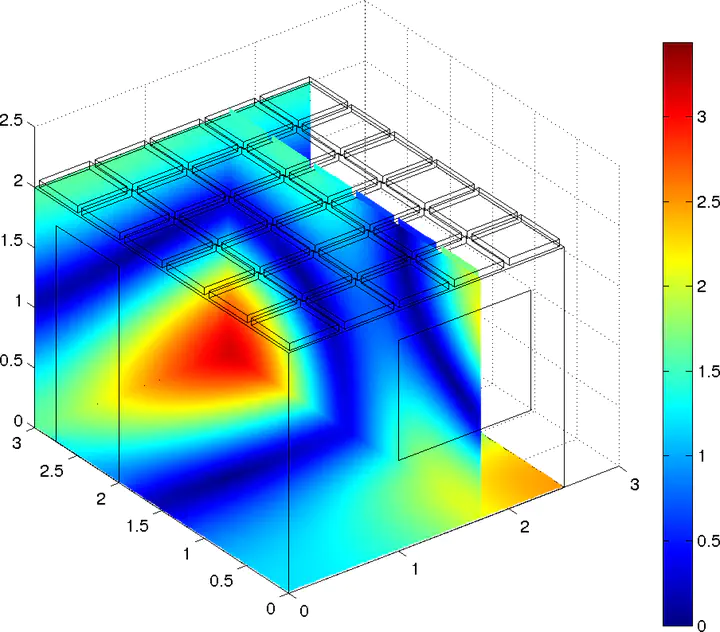 Slices of the pressure field in the interior of a room with active control
Slices of the pressure field in the interior of a room with active controlIn this project, the numerical study is focused on the comparative study of three different strategies with the objective of reducing the broadband noise in an interior room, by means of passive-active cells supported on the ceiling. Each actuation unit is composed by a box with lateral rigid walls, a porous veil in the front face (in contact with the air room cavity), and it contains a combination of sensors (microphones) and actuators (local loudspeakers) in the cell interior, which allows to implement different feedback strategies of active control (see reference [1]).
More precisely, the so-called pressure release and the impedance matching s trategies have been tested in an 5x6 array configuration in two actuation scenarios: a) the entire cell system is turn on, and b) only five of the cells are acting on the noise room. In both cases, the root mean square of the pressure field (measured in decibels) has been compared for a low frequency range where classical passive solutions, based on absorbing materials, do not work efficiently.
 Figure 1: Root-mean-square of the pressure field (in decibels (dB))
computed in the interior room with three different passive-active strategies.
Figure 1: Root-mean-square of the pressure field (in decibels (dB))
computed in the interior room with three different passive-active strategies.
Figure on the top shows three two-dimensional slices of the pressure field in the interior of a room. In this numerical simulation, the noise source is supposed to come from the corridor joint to a door (see left front wall) and a window (see right front wall) has been assumed to behaves as an absorbing surface. If the entire 5x6 array is adaptively acting to minimize the root-mean-square of the pressure measured by the sensors, both control active strategies has been compared at different frequencies (see Figure 1), showing different response in the frequency band from 10Hz to 275Hz. As in this proposed collaboration project, the simulation code has been developed specifically to handle accurately not only the acoustical modeling of the room but also to deal with the optimization of the adaptive control strategies of the unit cells.
References
[1] A. Bermúdez, P. Gamallo, L. Hervella-Nieto, A. Prieto.Numerical simulation of active-passive cells with microperforated plates or porous veils.
Journal of Sound and Vibrations, 329 (2010), 3233-3246.